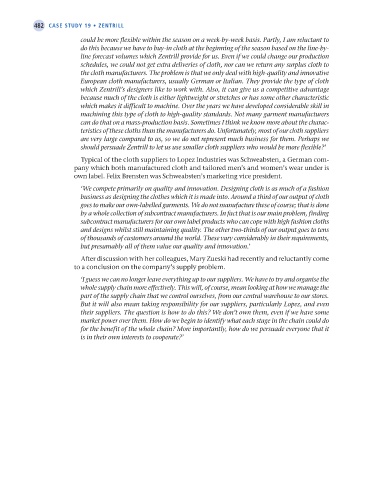Page 507 - Operations Strategy
P. 507
482 case study 19 • ZeNtRILL
could be more flexible within the season on a week-by-week basis. Partly, I am reluctant to
do this because we have to buy-in cloth at the beginning of the season based on the line-by-
line forecast volumes which Zentrill provide for us. Even if we could change our production
schedules, we could not get extra deliveries of cloth, nor can we return any surplus cloth to
the cloth manufacturers. The problem is that we only deal with high-quality and innovative
European cloth manufacturers, usually German or Italian. They provide the type of cloth
which Zentrill’s designers like to work with. Also, it can give us a competitive advantage
because much of the cloth is either lightweight or stretches or has some other characteristic
which makes it difficult to machine. Over the years we have developed considerable skill in
machining this type of cloth to high-quality standards. Not many garment manufacturers
can do that on a mass-production basis. Sometimes I think we know more about the charac-
teristics of these cloths than the manufacturers do. Unfortunately, most of our cloth suppliers
are very large compared to us, so we do not represent much business for them. Perhaps we
should persuade Zentrill to let us use smaller cloth suppliers who would be more flexible?’
Typical of the cloth suppliers to Lopez Industries was Schweabsten, a German com-
pany which both manufactured cloth and tailored men’s and women’s wear under is
own label. Felix Brensten was Schweabsten’s marketing vice president.
‘We compete primarily on quality and innovation. Designing cloth is as much of a fashion
business as designing the clothes which it is made into. Around a third of our output of cloth
goes to make our own-labelled garments. We do not manufacture these of course; that is done
by a whole collection of subcontract manufacturers. In fact that is our main problem, finding
subcontract manufacturers for our own label products who can cope with high fashion cloths
and designs whilst still maintaining quality. The other two-thirds of our output goes to tens
of thousands of customers around the world. These vary considerably in their requirements,
but presumably all of them value our quality and innovation.’
After discussion with her colleagues, Mary Zueski had recently and reluctantly come
to a conclusion on the company’s supply problem.
‘I guess we can no longer leave everything up to our suppliers. We have to try and organise the
whole supply chain more effectively. This will, of course, mean looking at how we manage the
part of the supply chain that we control ourselves, from our central warehouse to our stores.
But it will also mean taking responsibility for our suppliers, particularly Lopez, and even
their suppliers. The question is how to do this? We don’t own them, even if we have some
market power over them. How do we begin to identify what each stage in the chain could do
for the benefit of the whole chain? More importantly, how do we persuade everyone that it
is in their own interests to cooperate?’
Z19 Operations Strategy 62492.indd 482 02/03/2017 14:02

